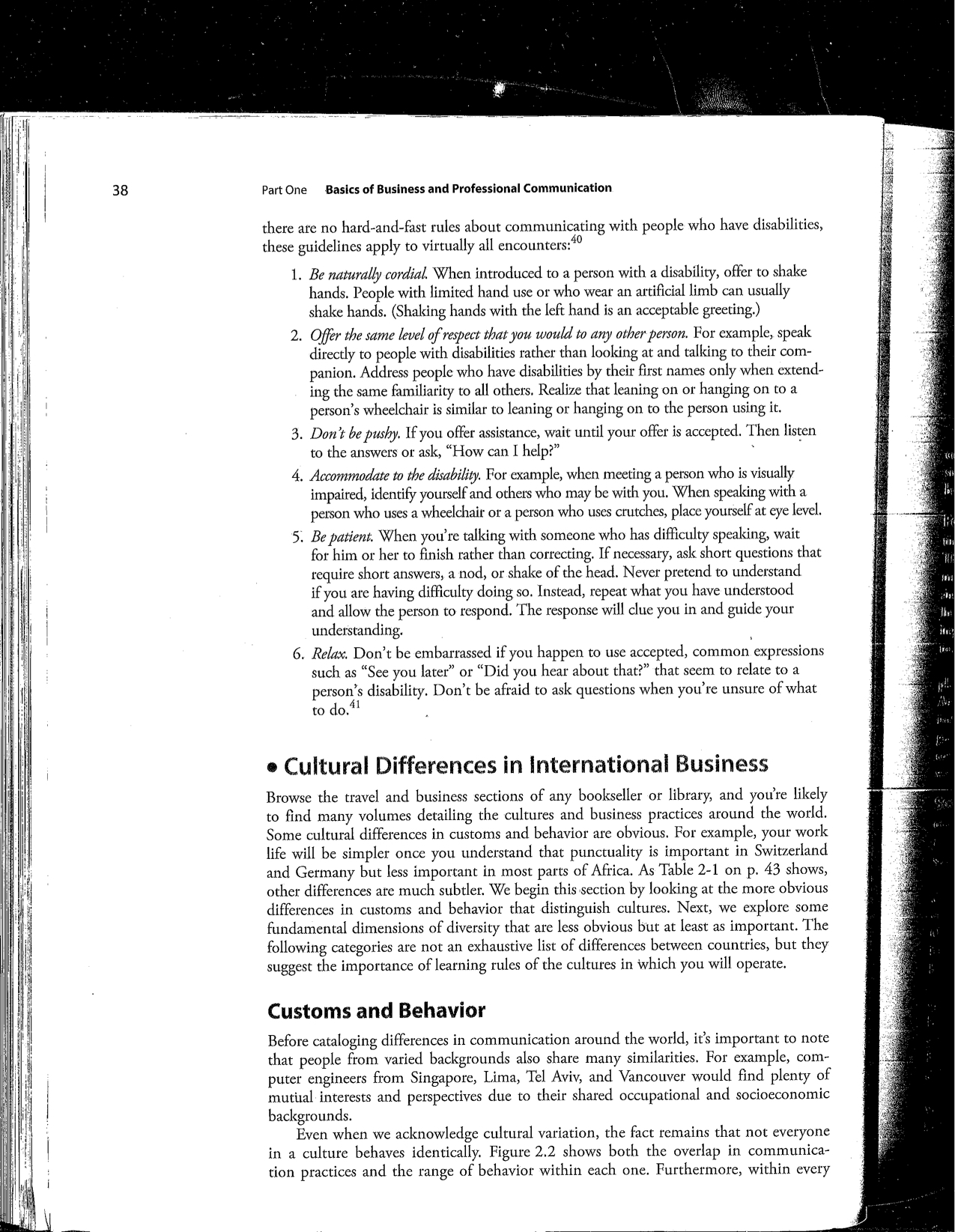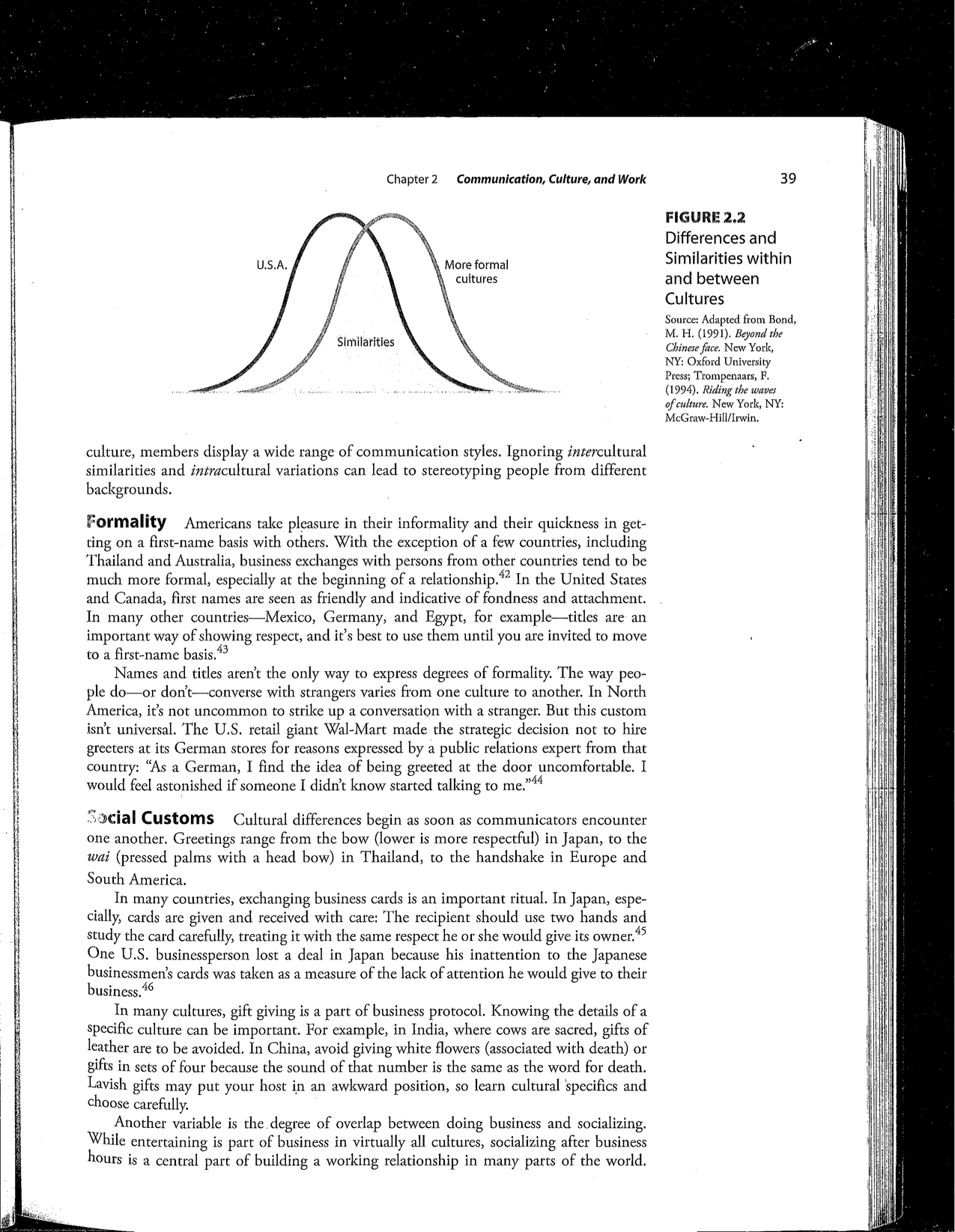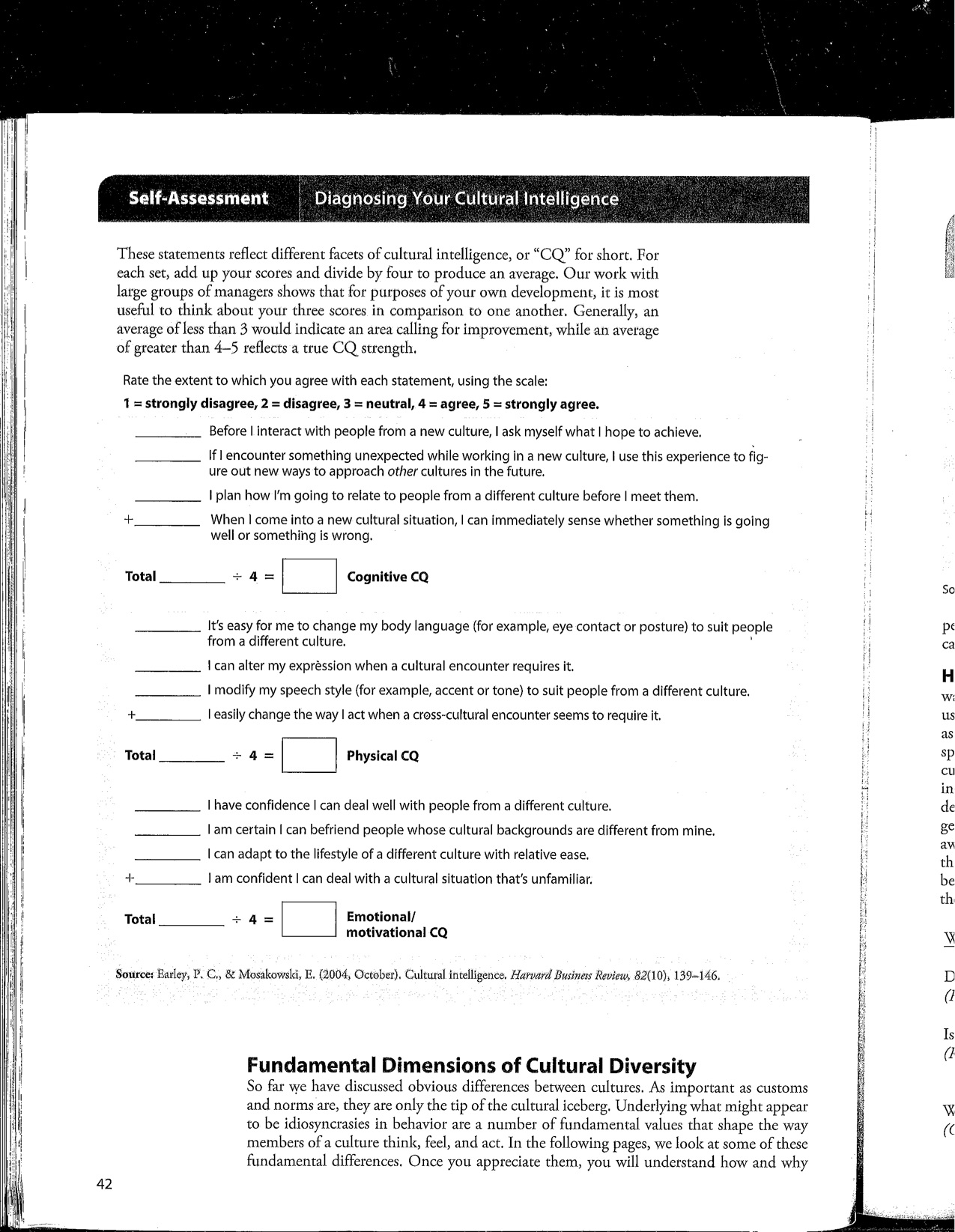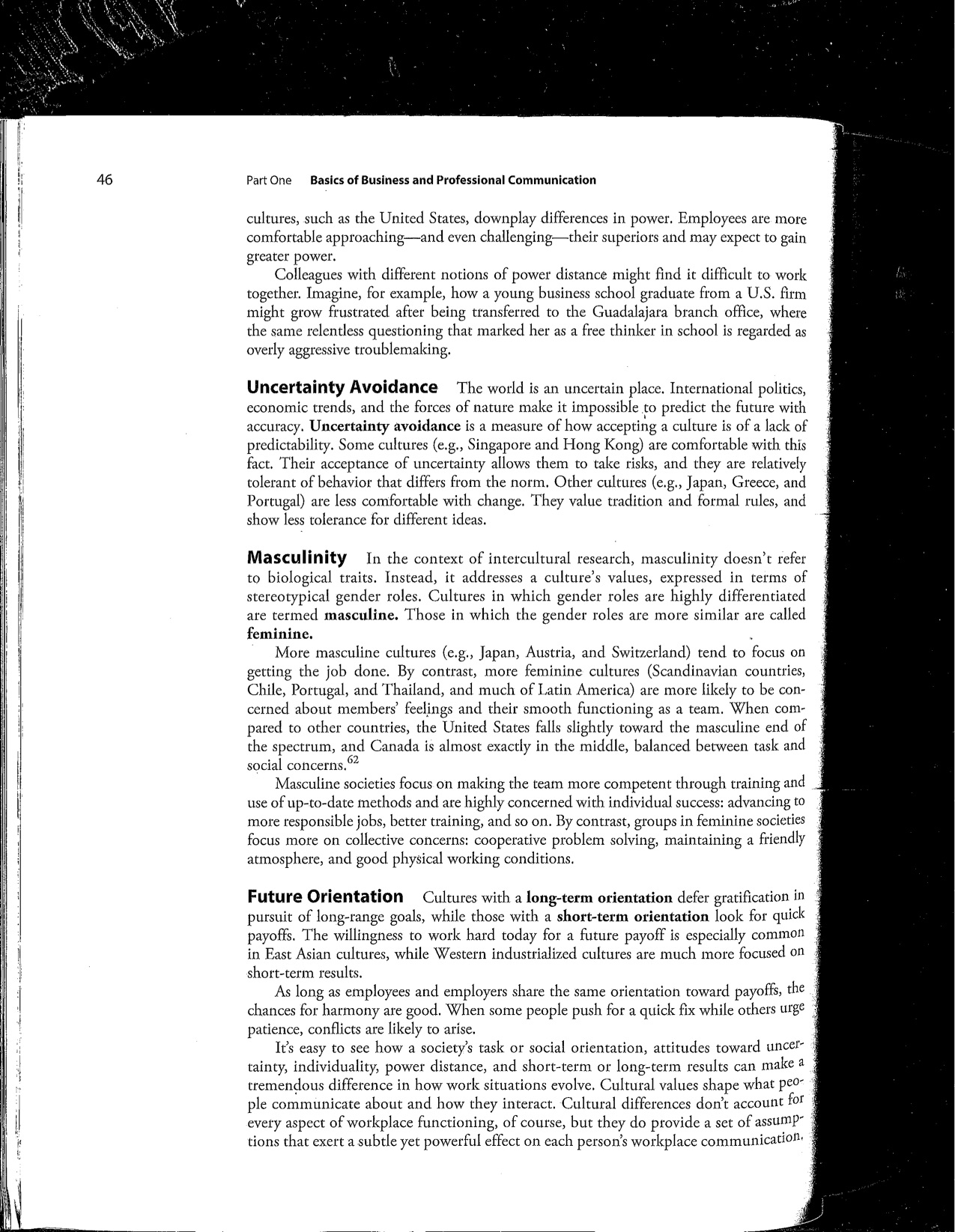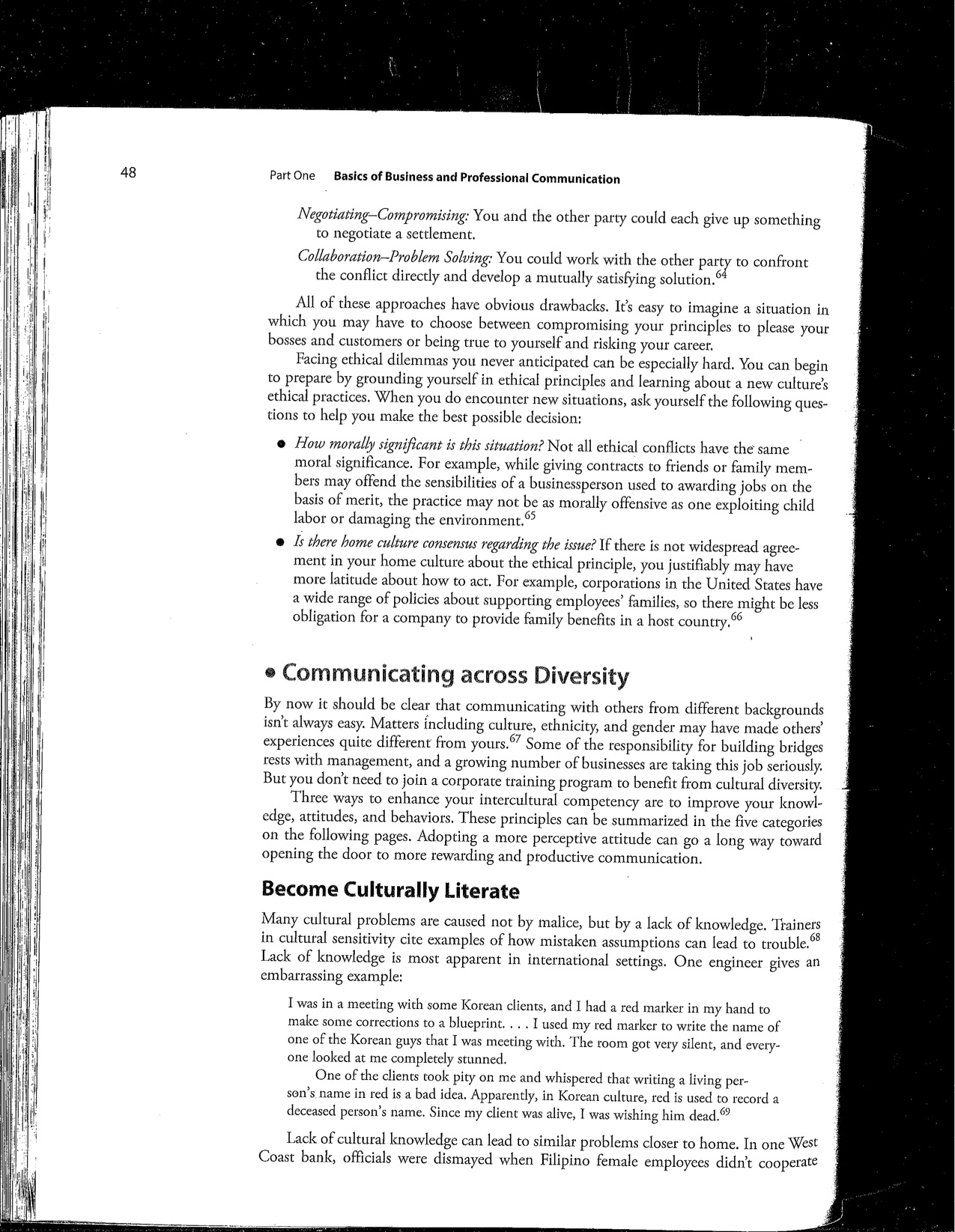Reference Textbook - Communicating at Work: Strategies for Success in Business and the Professions11th Edition
In this two-part activity, you will demonstrate an understanding of cultural differences, ethical
challenges and ways to manage diversity issues.
Part I:Describe and Compare/Contrast Two Different Cultures
Describe the cultural characteristics of your country of origin according to the categories discussed on pp 38-46 of the textbook and compare and contrast these to the U.S. culture.If you are from the U.S., pick any other country and compare it to the U.S. culture.
You should comment on (describe and compare/contrast) the two cultures across each of the twelve cultural characteristics described in chapter two: Formality and Social Customs, Style of Dress, Time, Tolerance for Conflict, Gender Roles, High- and Low- Context, Individualism, Power Distance, Uncertainty Avoidance, Masculinity, and Future Orientation.
Once completed, address the followingquestions:
1)From the set of twelve cultural characteristics you described above, which cultural difference between these two cultures is likely to provide the biggest challenge when business teams from both cultures work together?And why?(See pp 38-46)
2)What can you do to improve or ease challenges when communicating across these two cultures?(See pp 48-52)
3)Are there any ethical issues that might arise when doing business between these two different cultures? (See pp 47-48)
Part II: Situation Analysis
In this scenario, you are a manager of a work team in the U.S.Your team is visiting a client in another country where they treat women in the workplace differently. The purpose of your visit is to deliver a presentation of findings (results) from a research project that your team performed, for a fee, for the client.The client has hinted that only men should deliver presentations during meetings in their country.Your team is composed of three employees?two men and one woman.Each team member worked on the research project. When your team has performed this same type of research project in the past for other clients, each team member (the two men and the woman) has delivered a portion of the presentation and has contributed equally to the discussion.In this current situation, the woman on your team feels uncomfortable about the upcoming visit.
Questions:
1)As the manager of this team, which of the 6 ways of responding described on pp 47-48 (AvoidingthroughCollaboration) would you choose and why?
2)Consider the two ethical questions on pg 48 (e.g.,How morally significant is this situation? Is there home culture consensus regarding the issue?)and look at the questions in the "Ethical challenge" box at the top of pg 47.As you think about these questions and how you would answer them, does this change how you would respond to the situation above?
3)What if anything would you do or say your employee (the woman), to your entire team, or to the client to improve the situation?
4)What are some possible consequences that might occur after you follow your chosen response?
5)What might you do to alleviate this type of conflict in the future?
Part One Basics of Business and Professional Communicatlon there are no hatdandfast rules about communicating with people who have disabilities, these guidelines apply to virtually all encounters?m 1. Be entertain! cordial. When introduced to a person with a disability, offer to shake hands. People with limited hand use or who wear an articial limb can usually shake hands. (Shaking hands with the left hand is an acceptable greeting.) . Or the same level ryfmpecr thatyau would to any ether-person. For example, speak directly to people with disabilities rather than looking at and talking to their com- panion. Address people who have disabilities by their first names only when extend ing the same familiarity to all others. Realize that leaning on or hanging on to a person's wheelchair is similar to leaning or hanging on to the person using it. 3. Don't 56192619}. If you offer assistance, wait until your offer is accepted. Then listen to the answers or ask, \"How can I help?\" ' 4. Accommodate to ob: My. For example, when meeting a person who is visually impaired, identify yourself and others who may be with you. When speaking with a person who uses a wheelchair or a person who usm crutches, place yourself at eye level. L Be potion. When you're talking with someone who has difficulty speaking, wait for him or her to finish rather than correcting. If necessary, ask short questions that require short answers, a nod, or shake of the head. Never pretend to understand if you are having difficulty doing so. Instead, repeat what you have understood and allow the person to respond. The response will clue you in and guide your understanding. . Relax. Don't be embarrassed if you happen to use accepted, common expressions such as \"See you later\" or \"Did you hear about that?\" that seem to relate to a person's disability. Don't be afraid to ask questions when you're unsure of what to do.'\" a Cultural Differences in International Business Browse the travel and business sections of any bookseller or library, and you're likely to nd many volumes detailing the cultures and business practices around the world. Some cultural differences in customs and behavior are obvious. For example, your work life will be simpler once you understand that punctuality is important in Switzerland and Germany but less important in most parts of Africa. As Table 2-1 on p. 43 shows, other differences are much subtler. We begin this section by looking at die more obvious differences in customs and behavior that distinguish cultures. Next, we explore some fundamental dimensions of diversity that are less obvious but at least as important. The following categories are not an exhaustive list of differences between countries, but they suggest the importance of learning rules of the cultures in which you will operate. Customs and Behavior Before cataloging differences in communication around the world, it's important to note that people from varied backgrounds also share many similarities. For example, com puter engineers from Singapore, Lima, Tel Aviv, and Vancouver would find plenty of mutual interests and perspectives due to their shared occupational and socioeconomic backgrounds. Even when we acknowledge cultural variation, the fact remains that not everyone in a culture behaves identically. Figure 2.2 shows both the overlap in communica tion practices and the range of behavior within each one. Furthermore, within every i Chapter 2 Communication, Culture, and Work U.S.A. More formal cultures Similarltles culture, members display a wide range of communication styles. Ignoring intercultural similarities and intracultural variations can lead to stereotyping people from different backgrounds. Formality Americans take pleasure in their informality and their quickness in get ting on a fii'stmame basis with others. With the exception of a few countries, including Thailand and Australia, business exchanges with persons from other countries tend to be much more formal, especially at the beginning of a relationship}2 In the United States and Canada, rst names are seen as friendly and indicative of fondness and attachment. In many other countriesMexico, Germany, and Egypt, for exampletitles are an important way of showing respect, and it's best to use them until you are invited to move to a firstname basis.43 Names and titles aren't the only way to express degrees of formality. The way peo- ple door don'tconverse with strangers varies from one culture to another. In North America, it's not uncommon to strike up a conversation with a stranger. But this custom isn't universal. The U.S. retail giant Wei-Mart made the strategic decision not to hire greeters at its German stores for reasons expressed by a public relations expert from that country: \"As a German, I nd the idea of being greeted at die door uncomfortable. I would feel astonished if someone I didn't know started talking to med\"M Eocial Customs Cultural differences begin as soon as communicators encounter one another. Greetings range from the bow {lower is more respectful) in Japan, to the WM (pressed palms with a head bow) in Thailand, to the handshake in Europe and South America. In many countries, exchanging business cards is an important ritual. In Japan, espe cially, cards are given and received with care: The recipient should use two hands and study the card carefully, treating it with the same respect he or she would give its owner.'is One US. businessperson lost a deal in Japan because his inattention to the lapanese businessmen's cards was taken as a measure of the lack of attention he would give to their business.46 In many cultures, gift giving is a part of business protocol. Knowing the details of a Specic culture can be important. For example, in India, where cows are sacred, gifts of leather are to be avoided. In China, avoid giving white owers (associated with death) or gifts in sets of four because the sound of that number is the same as the word For death. Lavish gifts may put your host in an awkward position, so learn cultural 'specifics and Choose carefully. Another variable is the degree of overlap between doing business and socializing. While entertaining is part of business in virtually all cultures, socializing after business limits is a central part of building a working relationship in many parts of the world. 39 FIGURE 2.2 Differences and Similarities within and between Cultures Source: Adapted From Bond, M. H. (1991). Squndtne Chinmce. New York1 NY: Oxford University Press: Trompenaars, F. (1994]. Riding the was: afmlmrz. New York, NY: McGrawAl-Iillllrwln. u... -m._..._,v-s 40 Part One Basics of Business and Professional Communication In much of eastern Asia, drinking is regarded as a way of bonding that carries over into working relationships. One consultant alerts travelers to be prepared for a turn singing in the karaoke bars that are part of the scene in China, Japan, and other countries in the region}? Styles of Dress As travel and communication make the world feel like a smaller place, regional dif ferences in clothing are becoming less pronounced. For men, the standard Western business suit is common in many urban settings. For both men and women abroad, conservative dress will take you much further than the latest fad or fashion. In Muslim countries, women can show respect with modest dress, including longer sleeves and lower hemlines than may be fashion- able elsewhere. And women doing business in these countries might consider covering their hair, even if veiling is not part of their personal religion. Even in an era of international business, local differences exist. For example, when United Parcel Service entered the German market, it belatedly discovered the firm's sig- nature brown uniforms evoked unpleasant memories of brown-shirted Nazi storm troop- ers. In indonesia, the company had to modify its usual business suit dress rule and allow executives to wear more casual attire common in that hot and humid climateflB Time In international business, the first shock for travelers from the United States may be the way members of other cultures understand and use time. North Americans, like most northern Europeans, have what anthropologists term a monochronic view of time, seeing it as an almost tangible substance. American speech reects this attitude when people talk about saving time, making time, having time, wasting time, using time, and taking time. In U.S. culture. time is money. so it is rationed carefully. People schedule appointments and rigidly adhere to them. Tasks are performed in a scheduled order, one at .a time. This monochronic orientation is not universal. Cultures with a polychronic orienta- tion see time as more fluid. Meetings go on for as long as they take; they don't abruptly end because \"it's time." Most Latin American cultures, as well as southern European and Middle Eastern cultures, have a polychronic orientation. In Mexico, for example, \"you make friends first and do business later," according to R. C. Schrader, who heads California's trade oiiice in Mexico City.49 Members of poiychronic cultures are less concerned with punctuality than those raised with monochronic standards. It is not that being punctual is unimportant; it is just that other relational Factors may take priority. This fact helps explain why the notion of being \"on time" varies. Extremely monochronic cultures view even small delays as an offense. In polychronic cultures, varying degrees of lateness are acceptable-whom roughly 15 minutes in southern Europe to part, or sometimes even all, of the day in the Middle East and Africa.SD Tolerance for Conflict In some cultures, each person is responsible for helping to maintain harmony of a group and of society. The maintenance and pursuit of harmony is expressed in the Japanese term war. In Chinese, a similar term is zbong be.\" In other placesthe Middle East and southern Europe, for exampleharmony takes a backseat to emotional expression. Figure 2.3 illustrates how the rules for expressing emotions vary around the world. Chapter 2 Communication, Culture, and Work The cultural avoidance of conflict means most Asian businesspeople will probably not say no directly to you, fearing you will lose face and suffer embarraSsment. To help you maintain harmony and save face, they might spare you unpleasant news or informa- tion; it will be softened so you don't suffer disgrace or shame, especially in front of others. You may be told they will consider the matter or that it would be very difficult. Mexican business culture also values harmony and discourages confrontation. This attitude creates problems when it clashes with more aggressive standards that US. businesspeople usually bring to transactions. As president of Black 8.: Decker Latin America, Jose Maria Gonzales is used to working with colleagues and suppliers from north of the border. Despite that fact, he says coping with the difference between US. and Mexican approaches to conflict doesn't come easily: In a meeting Americans can argue, hit the table and leave as if nothing happened, while a Mexican might not forgive you for three months. I have to make sure not to person- alize things sometimes.52 This sort of accommodation works both ways. People from cultures that seek har- mony can learn to adapt to and accept conflict; communicators from more aggressive societies like the United States can learn to appreciate the importance of harmony when communicating cross culturally. Once communicators learn to appreciate different sets of rules about how to express and handle disagreements, conducting business becomes much easier. Gender Roles Women from North America, Western Europe, and Australiawa Zealand who travel internationally are likely to be astonished and chagrined by the way they are regarded in some overseas cultures, where ideas of appropriate feminine behavior can be quite different. In some countries, a woman who outranlts a man may not be treated that way by hosts; the hosts may still speak to and prefer to negotiate with the male, assuming he is the woman's superior. In Asian countries and Muslim countries, VIVOHIen may find they are excluded from substantive conversation or overlooked in nego- tiations because of designated gender roles. Sometimes, a woman can establish greater Credibility by clarifying her title, role, and responsibilities in writing before a personal visit. but even this step won't guarantee the desired effect. The differences described here can present challenges when workers from different Cultures work together. Table 2-1 illustrates some of these challenges by listing differ- epoes between Chinese and Western businesspeople in both concerns and communica- tion styles. FIGURE 2.3 Percentage of Employees Who Would Openly Express Feeling U pset at Work Source: Trompenaars, F. (1994]. RidEwan: warm ufmirrzre. New York, NY: McGraw-Hillllrwin. SelfAssessment _ Diagnosing YourCultural Intelligence These statements reect different Facets of cultural intelligence, or \"CQ\" for short. For each set, add up your scores and divide by Four to produce an average. Our work with large groups of managers shows that for purposes of your own development, it is most . 4 useful to think about your three scores in comparison to one another. Generally. an average of less than 5 would indicate an area calling For improvement, while an average of greater than 45 reects a true CQ strength. Rate the extent to which you agree with each statement. using the scale: \"I = strongly disagree. 2 = disagree, 3 = neutral, 4 = agree, 5 = strongly agree. Before I interact with people from a new culture, I ask myself what I hope to achieve. lfl encounter something unexpected while working in a new culture, I use this experience to fig 1 ure out new ways to approach other cultures in the future. g I plan how I'm going to relate to people from a different culture before I meet them. i f + When I come into a new cultural situation, I can immediately sense whether something is going i well or something ls wrong. .- Total + 4 = l:\\ Cognitive CQ :5 s I a 0 It's easy for me to change my body language (for exampler eye contact or posture) to suit people S' P: from a different culture. ' 2; l ca r I can alter my expression when a cultural encounter requires it. i" H I modify my speech style (for example, accent or tone) to suit people from a different culture. : w: + I easily change the way I act when a cross-cultural encounter seems to require it. us as Total + 4 = |:| Physical co 5P on in I have condence i can deal well with people from a different culture. de I am certain I can befriend people whose cultural backgrounds are different from mine. ge i 5 an I can adapt to the lifestyle of a different culture with relative ease. '; th + lam condent I can deal with a cultural situation that's unfamiliar. _ .l be "i th- Total + 4 =.. l: Emotional! f motivational CQ F \\x :5 e Salim Harley, _P (3.. 8: Mosakomici, E. (2004, October). Cultural intelligence. Haw Business Revlon 8200), 139446. f:- D Is . . . (1' Fundamental Dimenslons of Cultural Dwersity So far we have discussed obvious differences between cultures. As important as customs and norms are, they are only the tip of the cultural iceberg. Underlying what might appear or to be idiosyncrasies in behavior are a number of Fundamental values that shape the way (r members of a culture think, Feel, and act. In the following pages, we loolt at some of these fundamental differences. Once you appreciate them, you will understand how and why 42 Chapter 2 Communication, Culture, and Work 43 Table 2-1 Contrasting Chinese-Western Concerns and Communication Practices Chinese Western Concerns Saving face Frankness, "honesty" Respect, politeness Assertiveness Compromise, flexibility Self-assurance General feeling, "spirit" Specific terms Social status Task at hand Patience Time efficiency Communication practices Reserved Extroverted Tentative Firm Personal Less personal No body contact Hugging, backslapping acceptable No pointing Index finger used to point Source: Chen, M. (2001). Inside Chinese business: A guide for managers worldwide. Boston, MA: Harvard Business School Press. people from different backgrounds behave as they do, and you will have ideas of how you can adapt to improve the quality of your communication with others. High- and Low-Context Anthropologist Edward Hall identified two distinct ways in which members of various cultures deliver messages." A low-context culture uses language primarily to express thoughts, feelings, and ideas as clearly and logically as possible. To low-context communicators, the meaning of a statement is in the words spoken. By contrast, a high-context culture relies heavily on subtle, often nonverbal cues to convey meaning, save face, and maintain social harmony. Communicators in these societies learn to discover meaning from the context in which a message is delivered: the speaker's nonverbal behaviors, the history of the relationship, and the general social rules that govern interaction between people. When delivering difficult or awkward messages, high-context speakers often convey meaning through context rather than plainly stated words to avoid upsetting their listeners. Consider a few differences the same idea:$4 between how a low-context Westerner and a high-context Chinese person might express Western Chinese Do you understand? Am I being clear? (Responsibility placed on other.) (Speaker takes responsibility for understanding.) Is the project acceptable? What do you think of the project? (Requires direct yes or no answer.) (Gives respondent latitude to reply diplomatically.) We can't do that. "Clear refusal could be perceived as harsh.) This may be a little difficult for us to do. (Context makes it clear that the answer is still no.)is important, so communicators avoid speaking directly if thht would mmatn another person's dignity. One U.S. project manager describes how her insensitivity to high-context communication almost derailed an international team in developing a Japanese-language version of an Internet search service: As an American project manager, 1 was expecting that if i was proposing something stupid, I would hear it from the people on me team. In reality, I had a plan with a fatal flaw. and the Japanese team members knew it, but it was not their style of communica- tion to embarrass me by telling mess . Even within a single country, (Jocultures can have different notions about die i value of direct speech. For example, Puerto Rican language style resembles high-context Japanese or Korean more than lowcontext English. As a group, Puerto Ricans value social harmony and avoid confrontation, which leads them to speak in indirect ways to avoid od'endingf The same holds true For Mexican Americans, as communication researcher Don Locke explains: Whereas members of the dominant culture of the United States are taught to value openness, frankness, and directness, the traditional MexicanAmerican approach requires the use of much diplomacy and tact when communicating with another indi- vidual. Concern and respect for the Feelings of others dictate that a screen be provided. behind which an individual may preserve dignity. . . . The manner of expression is likely to be elaborate and indirect, since the aim is to make the personal relationship at least appear harmonious, to show respect for the other's individuality. To the Mexican- .Amerlcan, direct argument or contradiction appears rude and disrespectful.\" A preference for high or lowcontext communication isn't the only factor that dis- tinguishes one culture from another. One survey of 160,000 employees in 60 countries rcvealed several other ways in which the worldviews of one national culture can dL'er From those of another.58 Table 22 lists those dimensions and the styles that are most Common ln some countries. We will look at those differences now. Individualism Members of individualistic cultures are inclined to put their own interests and those of their immediate family ahead of social concerns. Individualistic cultures offer their members a great deal of freedom in the belief that this freedom makes it possible For each person to achieve personal success. Collectivist cultures, however, have right social frameworks in which members of a group (such as an organization) feel primary loyalty toward one another and the group to which they belong. China, like most East Asian cultures, is highly collective. In collectivist societies, members are expected to believe the welfare of the organization is as important as or even more important than their own.59 Workers are less likely to strive to become organizational \"stars,\" because that approach would dishonor other team members. \"You seldom see an individual Iapanese executive who stands above the rest until he is the most senior individual in the com any,\" says international corporate recruiter Richard M. Perry.6 The power of collectivist belief5 was illustrated when PepsiCo rewarded one of its managers in China with a sizable cash bonus that he divided equally among his subortiirtates.6l Chapter 2 Communication, Culture, and Work 45 Table 2 2 Cultural Values in Selected Countries Long-Term Orientation Short-Term Orientation China Pakistan Hong Kong Philippines Taiwan Norway Japan Canada South Korea East Africa* Individualistic Collectivistic United States Guatemala Australia Ecuador United Kingdom Panama Canada Venezuela New Zealand Pakistan, Indonesia Avoid Uncertainty Tolerate Uncertainty Greece Singapore Portugal Jamaica Uruguay Denmark Guatemala Sweden Belgium and El Salvador Hong Kong High Power Distance Low Power Distance Malaysia Austria Philippines Israel Mexico Denmark Arab world* * New Zealand China Ireland Masculine Feminine Japan Sweden Hungary Norway Austria Netherlands Italy Denmark Switzerland Costa Rica *Ethiopia, Kenya, Tanzania, Zambia. * Egypt, Iraq, Kuwait, Lebanon, Libya, Saudi Arabia, United Arab Emirates. Source: Adapted from Hofstede, G., Hofstede, G. J., & Minkov, M. (1997). Cultures and organizations: Software of the mind (3rd ed.). New York, NY: McGraw-Hill. Retrieved from http://www.geert-hofstede.com Power Distance The term power distance refers to attitudes toward differences in authority. Cultures with high power distance, such as Mexico and the Philippines, accept the fact that power is distributed unequally-that some members have greater resources and influence than others. In these cultures, differences in organizational status and rank are expected, routine, and clear-cut. Employees respect those in high positions. OtherPart One Basics of Business and Professional Communication cultures, such as the United States, downplay differences in power. Employees are more comfortable approachingand even challengingtheir superiors and may expect to gain greater power. Colleagues with different notions of power distance might nd it difcult to work together. Imagine, for example, how a young business School graduate from a U.S. firm might grow frustrated after being transferred to the Guadalajara branch office, where the same relentless questioning that marked her as a free thinker in school is regarded as overly aggressive troublemaking. Uncertainty Avoidance The world is an uncertain place. International politics, economic trends, and the forces of nature make it impossiblero predict the future with accuracy. Uncertainty avoidance is a measure of how accepting a culture is of a lack of predictability. Some cultures {e.g., Singapore and Hong Kong] are comfortable with this fact. Their acceptance of uncertainty allows them to take risks, and they are relatively tolerant of hehavior that differs from the norm. Other cultures (e.g., Japan, Greece, and . Portugal) are less comfortable with change. They value tradition and formal rules, and i show less tolerance for different ideas. ' " Masculinity In the context of intercultural research. masculinity doesn't refer to biological traits. Instead, it addresses a culture's values, expressed in terms of stereotypical gender roles. Cultures in which gender roles are highly differentiated are termed masculine. Those in which the gender roles are more similar are called feminine. . I More masculine cultures (cg, Japan, Austria, and Switzerland) tend to focus on getting the job done. By contrast, more feminine cultures (Scandinavian countries, Chile, Portugal, and Thailand, and much of Latin America} are more likely to be con cerned about members' feelings and their smooth functioning as a team. When com pared to other countries, the United States falls slightly toward the masculine end of the spectrum, and Canada is almost exactly in the middle, balanced between task and social concerns.62 _ Masculine societies focus on making the team more competent through training and . - use of up~to-date methods and are highly concerned with individual success: advancing to _ more responsible jobs, better training, and so on. By contrast, groups in feminine societies 3 focus more on collective concerns: cooperative problem solving, maintaining a friendly - atmosphere, and good physical working conditions. Future Orientation Cultures with a longterm orientation defer gratication in '5- pursuit of long-range goals, while those with a short-term orientation look for quick .' payoffs. The willingness to work hard today for a future payoff is especially commD\" _. in East Asian cultures, while Western industrialized cultures are much more focused on ..: short-term results. _ As long as employees and employers share the same orientation toward payoffs. the chances for harmony are good. \\When some people push for a quick fix while others urg = patience, conicts are likely to arise. It's easy to see how a society's task or social orientation, attitudes toward unr' -_ tainty, individuality, power distance, and shorteterm or long~terrn results can make a tremendous difference in how work situations evolve. Cultural values shape what 1380' :' pie communicate about and how they interact. Cultural differences don't account for -2 every aspect of workplace functioning, of course, but they do provide a set of assumP' ' tions that exert a subtle yet powerful effect on each person's workplace communication' -; ETHICAL challenge Asking Hard Questions about Ethical guidelines when faced with ethical challenges of Behavior your own Among its core values, electronics manufacturer Is the action legal? Texas Instruments (TI) includes a respect for indi- Does it comply with our values? viduals, a commitment to long-term relationships, a concern for the environment, and a sense of duty to If you do it, will you feel bad? the communities where it does business. How will it look in the newspaper? TI encourages employees to use the following If you know it's wrong, don't do it! guidelines whenever they have a concern about If you're not sure, ask. whether a business action is consistent with the company's values. This information is provided Keep asking until you get an answer. to TI employees on a business-card-size mini- Source: Texas Instruments, Inc. (2011), Corporate social responsibility. The TI ethics quick test. Retrieved from http://www.ti.com/corp/docs/ pamphlet to carry with them. You can use the same company/citizen/ethics/quicktest.shtml Diversity and Ethical Issues Some cultural differences may challenge your sense of what is normal or proper behavior without raising ethical questions. For example, you probably could readjust your sense of promptness or what to wear to a business meeting without facing any sort of moral dilemma. In other cases, though, doing business in an unfamiliar culture might challenge your fundamental sense of right and wrong. You might be offended by differing notions of gender equality. You could be shocked to learn that bribes or payoffs are considered a normal part of doing business. You could encounter favoritism toward friends and family members that offends your sense of fair play. You might see a profound disregard for the environment. There is growing recognition that businesses that operate in a worldwide economy need a universal code of business ethics. Toward that end, a collaboration of business leaders in Japan, Europe, and the United States have developed a code of ethics based on ideals from both East Asia and the West. Called the Caux Round Table Principles for Business, this code includes many communication-related prin- ciples, such as treating all employees with honesty and dignity, listening to employee suggestions, avoiding discriminatory practices, dealing with all customers fairly, and information. 63 avoiding industrial espionage and other dishonest means of acquiring commercial Despite this admirable effort, you may encounter ethical challenges arising out of cultural differences. In cases like these, you can respond in a variety of ways: Avoiding: You might refuse to do business in cultures that operate according to ethical principles different from yours. Accommodating: You could accept the different ethical system and conform to practices fundamentally different from yours. Forcing: You could insist on doing business in a way you believe is ethically proper. Educating-Persuading: You could try to convince the people with whom you want to do business why your set of ethical principles is more appropriate. 47Part One Basics of Business and Professional Communication NegotiangCampromr'ss'ng' You and the other party could each give up something to negotiate a settlement. Collaborarfawf'mblem Solving: You could work with the other par-6?! to confront the conict directly and develop a mutually satisfying solution. All of these approaches have obvious drawbacks. It's easy to imagine a situation in which you may have to choose between compromising your principles to please your bosses and customers or being true to yourself and risking your career. Facing ethical dilemmas you never anticipated can be especially hard. You can begin to prepare by grounding yourself in ethical principles and learning about a new culture's ethical practices. When you do encounter new situations, ask yourself the following ques- tions to help you make the best possible decision: o How morally signicant is this negation? Not all ethical conicts have the same I moral signicance. For example, while giving contracts to friends or family mem- bers may offend the sensibilities of a businessperson used to awarding jobs on the basis of merit, the practice may not be as morally offensive as one exploiting child labor or damaging the environment.65 I: there from culture comm regarding the isms? If there is not widespread agree- ment in your home culture about the ethical principle, you justiably may have more latitude about how to act. For example, corporations in the United States have a wide range of policies about supporting employees' families. so there might be less obligation for a company to provide family benefits in a host country.66 4 Communicating across Diversity By now it should be clear that communicating with others from different backgrounds isn't always easy. Matters including culture, ethnicity, and gender may have made others' experiences quite different from yours.\" Some of the responsibility for building bridges rests with management, and a growing number of businesses are taking this job seriously. But you don't need to join a corporate training program to benefit from cultural diversity. Three ways to enhance your intercultural competency are to improve your knowl edge, attitudes, and behaviors. These principles can be summarized in the five categories on the following pages. Adopting a more perceptive attitude can go a long way toward opening the door to more rewarding and productive communication. Become Culturally Literate Many cuitural problems are caused not by malice, but by a lack of knowledge. Trainers in cultural sensitivity cite examples of how mistaken assumptions can lead to trouble.'53 Lack of knowledge is most apparent in international settings. One engineer gives an embarrassing example: I was in a meeting with some Korean clients, and I had a red marker in my hand to make some corrections to a blueprint. . . . 1 used my red marker to write the name of one of the Korean guys that I was meeting with. The room got very silent, and every- one looked at me completely stunned. One of the clients took pity on me and whispered that writing a living per son's name in red is a bad idea. Apparently, in Korean culture, red is used to record a deceased person's name. Since my client was alive, I was wishing him dead.69 lack of cultural knowledge can lead to similar problems closer to home. In one West Coast bank, officials were dismayed when Filipino female employees didn't cooperate
